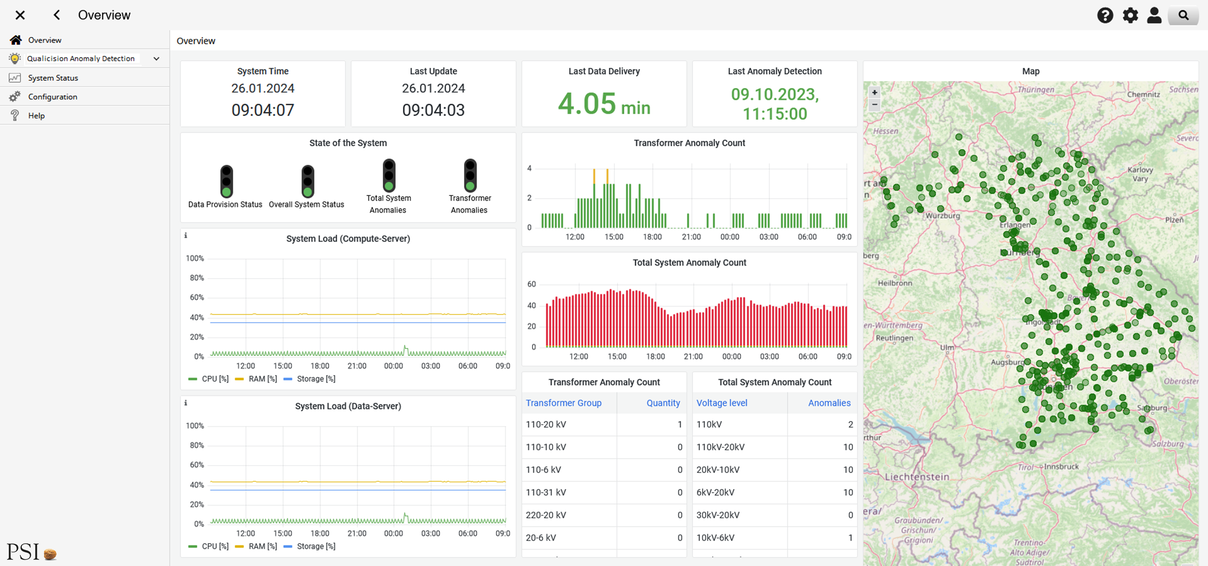PSIdetect reliably identifies relevant deviations in the power grid. This enables protective intervention as early as possible and thus in-creases the safety and reliability of the power supply.
The days when "voltage" in the electricity grid had a purely physical meaning are over. At least since Marc Elsberg's thriller Blackout, we know under “how much tension” grid operators are working today.
The danger of fiction becoming reality seems to be greater than ever. It does not even take a cyber-attack to increase the stress levels in the control rooms. More and more volatile distributed generation connected to the grid is challenging enough for the management of power grids. In addition, loads of electric cars and heat pumps have an impact on predictability. Managing volatile load and manifold operating situations requires real-time monitoring of the assets to allow for reacting quickly and specifically to faults as well as proactively counteracting dangers that are creeping up.
Systematic network monitoring
The software product PSIdetect developed jointly by E.ON and PSI uses artificial intelligence (AI) to detect abnormal behavior in network operations already at an early stage.
It is irrelevant whether the data comes from just one piece of equipment or relates to the entire network.
It detects abnormal behavior in generation and transformers, both separately and in a system context supporting equipment as well as network monitoring.
Let us take a closer look: PSIdetect obtains the electrical measurement data it works with from the control system.
"In order to train PSIdetect, training data such as historical and synthetically generated data as well as, during operations, current process and weather data are required," explains Stefan Dalhues, Researcher Grid Operations at PSI Software AG. "This data is used to continuously determine a target state and compare it with the actual state. The model parameters are obtained on the basis of historical data."
In order to train PSIdetect, training data such as historical and synthetically generated data as well as, during operations, current process and weather da-ta are required.
Traffic light dashboard provides a quick overview
The software automatically calculates an anomaly score indicating the condition of an asset or the system. For example, is something vibrating or heating up where it should not be vibrating or heating up?
Based on a continuous comparison with historical data and defined threshold values, PSIdetect identifies and displays even minimal changes and deviations from the expected (modeled) behavior. The traffic light display makes it possible to assess the situation at first glance by showing three statuses:
- Green symbolizing perfectly functioning operation.
- Yellow means a weak anomaly or potentially imminent technical problems.
- Red stands for a strong anomaly or an existing fault.
The system manager in the network control room automatically receives messages about the status.

The system reports abnormal behavior to the control room staff and subsequently the actual analysis commences:
- Was the deviating measurement from a sensor taken correctly or is the sensor defective and has triggered a false alarm?
- Was a value incorrectly parameterized during an upgrading activity?
- Has a piece of equipment been tampered with?
- Has an unusual situation (e.g., a solar eclipse) caused an exotic grid state?
A comparison with the operating log of the control system is also helpful.
Probability of occurrence and pattern recognition
What does AI do to detect anomalies? "We take two aspects into account in our AI," says Dalhues.
"Firstly, the software carries out a physical evaluation of the current grid status, for example of a transformer. A probability distribution for the high-voltage side of the transformer is stored for this purpose. In other words: What measured values can typically be expected? This makes it possible to determine how likely an operating state is. If an outlier is measured, its probability of occurrence can be evaluated. This can be done in parallel for several dimensions such as voltage, active power and reactive power. The parameters can be set in relation to each other and thus facilitate a comprehensive evaluation.
On the other hand, the software is capable of recognizing patterns, i.e., comparing behavior over time and thus identifying creeping changes."
Each anomaly search is automatically given a time stamp to make processes transparent. The detected anomaly is geographically located and can be shown on a network map so that users are immediately aware of where field crews need to go to rectify a technical problem. After activation, the control room personnel can view various details, such as a list of all the equipment being monitored for anomaly detection. Current anomaly scores are also displayed, as well as statistical data to better classify conditions.
Easy adaptation through individual parameterization
The user can switch the system on and off, for example, to avoid generating unnecessary error messages in the event of a major fault in the grid.
The sensitivity of software can be parameterized. The system can generate alarms already at user defined threshold values, not only when reaching the “red” status.
The system trains the AI usually periodically, but the user can trigger the training manually if relevant changes have been made to the grid. For example, if a large PV system is new to the grid and this is expected to have a major impact on grid management.
Anomaly detection offers a specific user interface based on the Java-based PSI platform. This facilitates seamlessly integrating the software with other PSI products. Administrators in the back office, service staff and system administrators use the UI to visualize network status and anomaly information as well as to configure the system.
Building block for compliance with the IT security act
"PSIdetect reliably identifies relevant deviations in the power grid, i.e., anomalies that can be attributed to possible attacks, technical faults or other influences. This enables protective intervention as early as possible and thus increases the safety and reliability of the power supply," summarizes Stefan Dalhues.
The software is therefore also an important building block for compliance with the IT Security Act, which requires grid operators to use anomaly detection for the control system level from May 2023 onwards. The target group are all grid operators with suitable measurement data. These can be municipal utilities, distribution or transmission grid operators. PSIdetect supports also area or industrial networks.

